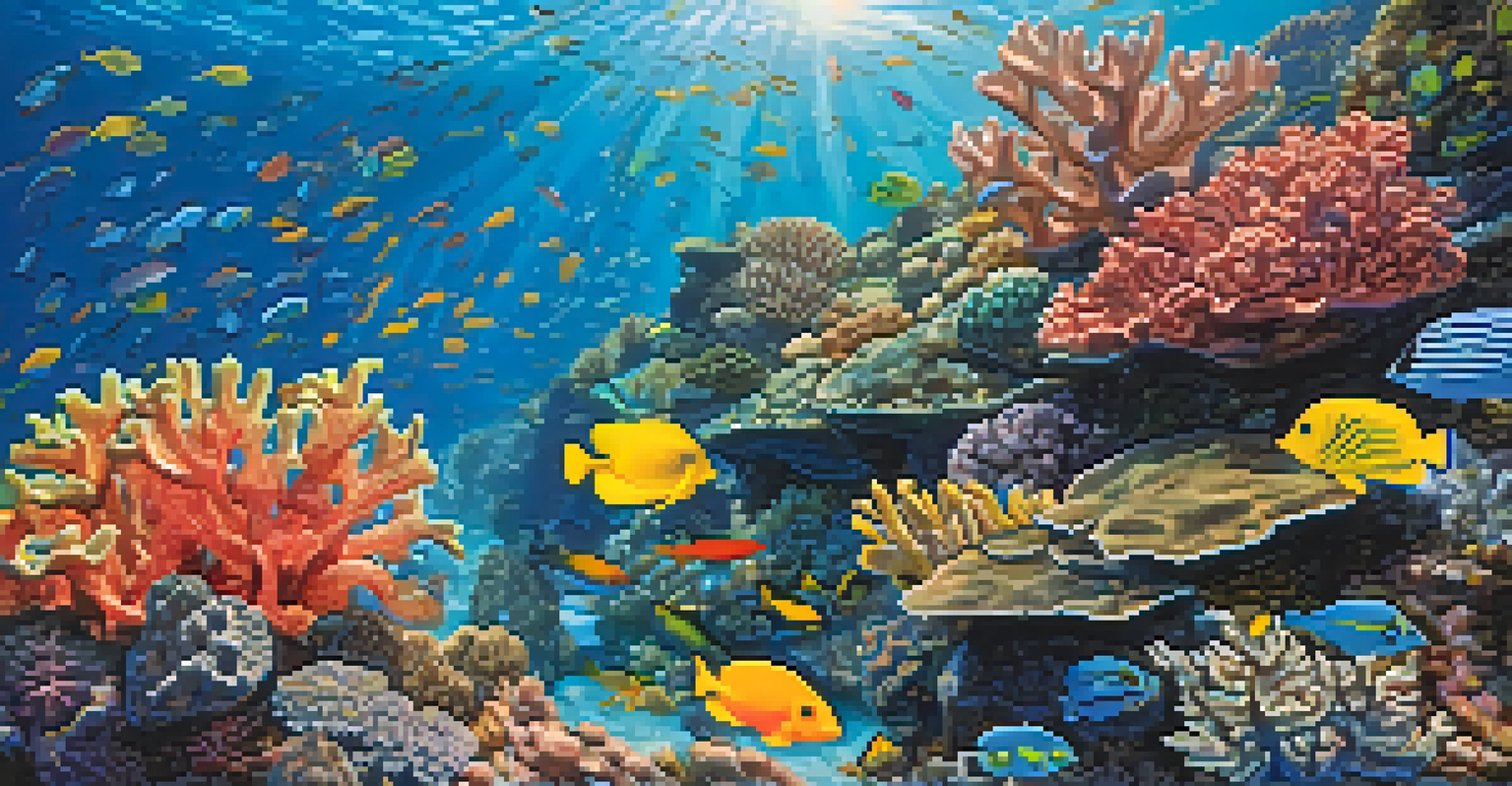Climate Change Effects on Hawaii's Flora and Fauna

Rising Temperatures Threaten Native Plant Species
Hawaii's native flora is uniquely adapted to its specific climate, but rising temperatures pose a significant threat. Many native plants, like the Hawaiian silversword, thrive in cooler, high-altitude environments, and as temperatures rise, their habitats are becoming less suitable. This shift could lead to decreased populations or even extinction of these endemic species, which are already vulnerable due to habitat loss.
The greatest threat to our planet is the belief that someone else will save it.
Moreover, higher temperatures can catalyze the spread of invasive species that outcompete native plants for resources. Invasive plants like the strawberry guava can quickly take over areas, choking out the delicate balance of native ecosystems. The loss of these native plants not only affects biodiversity but also the cultural heritage and practices of indigenous Hawaiian communities that rely on them.
As this intricate balance of life is disrupted, we may witness cascading effects throughout the ecosystem. Pollinators that depend on native plants for food may decline, leading to further challenges for plant reproduction. Ultimately, the rising temperatures in Hawaii are not just a statistic; they represent a real threat to the islands' unique and irreplaceable flora.
Changing Rainfall Patterns Impact Ecosystem Health
Climate change is altering rainfall patterns across Hawaii, leading to unpredictable and extreme weather events. Some regions may experience increased rainfall, resulting in flooding, while others may suffer from prolonged droughts. These shifts can drastically affect water availability for both plants and animals, creating stress on the entire ecosystem.

For instance, the Hawaiian honeycreeper, a bird species that relies on specific plants for food, could face food shortages due to changing flowering patterns. If certain plants bloom earlier or later than usual because of inconsistent rainfall, the honeycreeper may not find enough food during critical breeding seasons. This disconnect could lead to declines in their population and further disrupt the balance of the ecosystem.
Rising Temperatures Endanger Flora
Hawaii's native plant species are at risk of extinction due to rising temperatures and habitat loss.
Additionally, changing rainfall can increase the risk of soil erosion and runoff, further degrading habitats. This erosion not only impacts plant growth but also affects the freshwater systems that many species depend on. As these rainfall patterns shift, Hawaii's ecosystems must adapt quickly to survive, but the question remains: will they be able to?
Ocean Acidification Threatens Marine Life
Hawaii's surrounding waters are not immune to the effects of climate change, particularly ocean acidification. As carbon dioxide levels rise in the atmosphere, a significant portion is absorbed by the ocean, leading to a decrease in pH levels. This change can have dire consequences for marine organisms, especially coral reefs, which are vital to Hawaii's marine biodiversity.
In nature, nothing exists alone.
Coral reefs provide essential habitat for countless marine species, and their health is directly tied to the pH of ocean waters. With acidification, corals struggle to build their calcium carbonate skeletons, leading to coral bleaching and mass die-offs. This decline not only impacts the corals themselves but also the myriad of fish and invertebrates that rely on these reefs for shelter and food.
Moreover, the loss of coral reefs can have economic repercussions for local communities that depend on fishing and tourism. As these beautiful underwater ecosystems decline, the vibrant marine life that attracts visitors diminishes, threatening livelihoods. The effects of ocean acidification highlight the interconnectedness of climate change and the importance of protecting Hawaii's marine ecosystems.
Invasive Species Flourish in Changing Climate
Climate change creates ideal conditions for invasive species to thrive in Hawaii, further threatening native flora and fauna. Warmer temperatures and altered rainfall patterns can enhance the growth of non-native species, which often outcompete local varieties for resources. This invasion can lead to a cascade of negative effects, pushing native species closer to extinction.
For example, the rapid spread of the invasive fireweed threatens native plants by outcompeting them for sunlight and nutrients. As these invasive plants dominate the landscape, the unique evolutionary adaptations of Hawaii's native species become less relevant, leading to a loss of biodiversity. This loss is not just a statistic; it affects the entire ecosystem and the cultural practices of the local communities.
Invasive Species Disrupt Ecosystems
Climate change creates favorable conditions for invasive species, which threaten the survival of native flora and fauna.
Additionally, invasive animal species, such as rats and mongoose, pose a direct threat to native bird populations. These predators can decimate ground-nesting birds, which have no natural defenses against them. The increasing presence of invasive species due to climate change underscores the urgent need for conservation efforts to protect Hawaii's unique ecosystems.
Shifts in Habitat Range Affect Wildlife Survival
As climates shift, many species are forced to adapt by changing their habitat ranges, and Hawaii's wildlife is no exception. Some animals may migrate to higher elevations or latitudes in search of more favorable conditions. However, with limited land available in Hawaii, many species face significant challenges in finding suitable new habitats.
For instance, the Hawaiian petrel, which nests in high-altitude areas, is increasingly pushed to adapt to new environments as climate conditions change. Unfortunately, these birds face obstacles such as habitat destruction and competition from invasive species, making survival even more difficult. The pressure of climate change could lead to reduced populations and further threaten their existence.
Moreover, these shifts can disrupt established ecosystems, leading to unforeseen consequences. As certain species move to new areas, they may interact with other species in ways that could upset the balance of local ecosystems. The struggle for survival amidst changing habitats emphasizes the resilience of wildlife, but also the critical need for conservation efforts in the face of climate change.
Impact on Cultural Practices and Indigenous Knowledge
The effects of climate change on Hawaii's flora and fauna extend beyond environmental concerns; they also impact the cultural practices of indigenous communities. Many native plants and animals are integral to Hawaiian traditions, cuisine, and medicine. As these species become endangered or extinct, the loss is felt deeply within the community.
For instance, the traditional practice of hula relies on native plants for the creation of instruments and attire. As these plants decline, the cultural expressions tied to them may also fade away. The wisdom and knowledge passed down through generations about native species are at risk, threatening the cultural identity of the Hawaiian people.
Cultural Practices Face Climate Threats
The decline of native species jeopardizes the cultural traditions and practices of indigenous Hawaiian communities.
Furthermore, the interconnection between nature and culture means that the survival of native species is crucial for maintaining traditions and practices. The impacts of climate change challenge not only environmental sustainability but also the cultural heritage that enriches Hawaii. Recognizing and supporting indigenous knowledge is essential for fostering resilience in the face of climate change.
Conservation Efforts to Combat Climate Change Effects
In light of the challenges posed by climate change, various conservation efforts are underway to protect Hawaii's unique ecosystems. Organizations and local communities are collaborating to restore habitats, control invasive species, and protect endangered native plants and animals. These initiatives are crucial for preserving the islands' biodiversity and cultural heritage.
For example, reforestation projects aim to restore native forests by planting indigenous trees and controlling invasive species. These efforts not only enhance biodiversity but also improve carbon sequestration, helping mitigate climate change impacts. Community involvement is key, as local knowledge and passion drive successful conservation initiatives.

Additionally, education and awareness campaigns play an essential role in fostering a conservation mindset among residents and visitors. By understanding the importance of Hawaii's unique flora and fauna, individuals can contribute to conservation efforts, whether through responsible tourism or active participation in local initiatives. Together, these efforts can help protect Hawaii's ecosystems for future generations.